Cochlear implants convert sound into electrical impulses by first capturing sounds with a microphone in your external processor. This processor analyzes and digitizes the audio signals, then wirelessly transmits them to an internal receiver-stimulator. This device converts the digital signals into precise electrical impulses that are sent directly to electrodes implanted in your cochlea, stimulating your auditory nerve. If you continue exploring, you’ll discover how this process enables you to experience a more natural hearing sensation.
Key Takeaways
- Microphones capture sound vibrations and convert them into analog electrical signals.
- Signal processors analyze and refine these signals for clarity and noise reduction.
- Digital encoding samples and quantizes the signals into numerical data for accurate representation.
- Encoded signals are wirelessly transmitted to the internal receiver-stimulator.
- The device converts the digital signals into electrical impulses delivered to auditory nerve fibers via electrodes.
The Components of a Cochlear Implant System
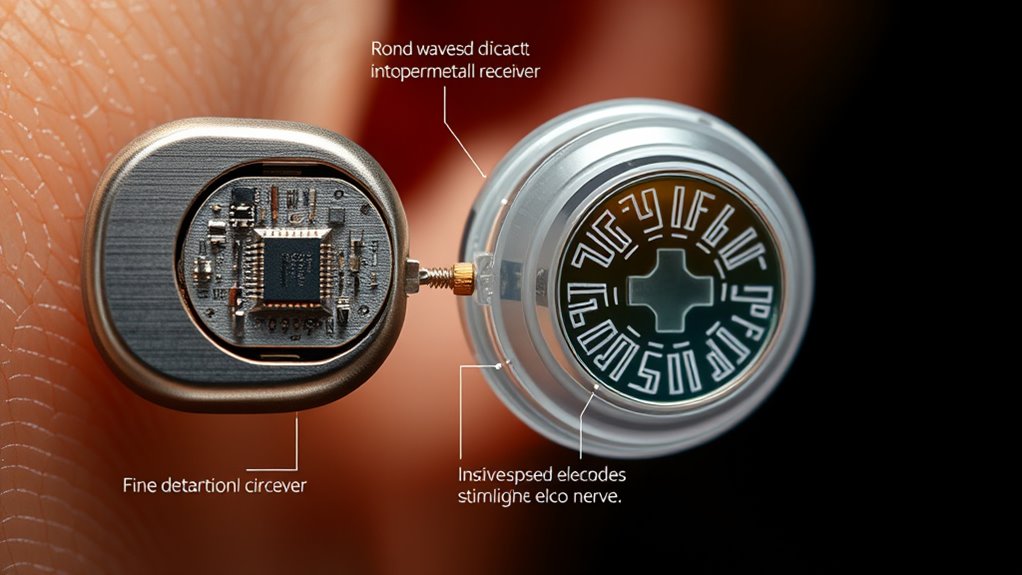
A cochlear implant system consists of several key components that work together to convert sound into electrical signals your brain can interpret. The external part includes a microphone and processor, which captures and analyze sounds. Inside, the receiver-stimulator is implanted surgically, connecting to electrodes placed in the cochlea. Battery technology is crucial, powering the external processor and ensuring reliable operation throughout the day. Advances in battery design, like rechargeable options, improve convenience and longevity. The surgical procedures involved are precise, requiring careful placement of the receiver and electrodes to maximize hearing restoration. Overall, each component’s design and function are vital to the device’s success, combining sophisticated technology with delicate surgical techniques to help you regain hearing. Understanding device components enhances appreciation for how these systems work seamlessly together.
Sound Capture and Processing
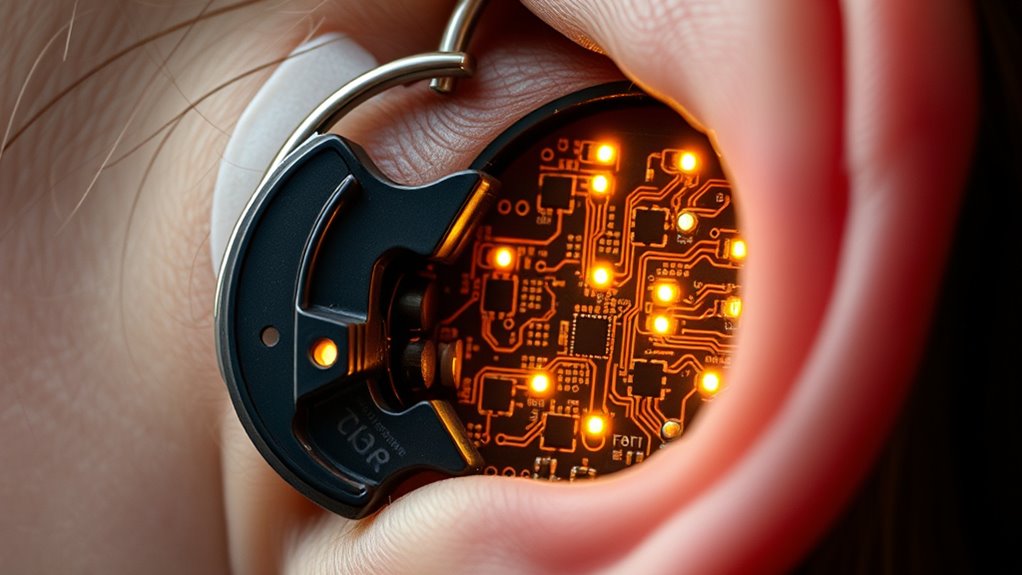
When sound reaches your cochlear implant, the microphone captures it and converts it into electrical signals. These signals then undergo processing and enhancement to improve clarity and reduce noise. Understanding how this step works is key to grasping how cochlear implants restore hearing.
Microphone Signal Conversion
Microphone signal conversion is the vital first step in transforming sound waves into digital signals that cochlear implants can interpret. Your device captures sound from various acoustic environments, which can include background noise or speech. To guarantee clarity, the microphone detects these sounds and converts them into electrical signals. Noise reduction algorithms are often integrated at this stage, helping to minimize unwanted sounds and focus on speech or important audio cues. This process is essential for creating a clean, accurate representation of the environment, allowing the implant to process sounds effectively. By filtering out background noise early, the cochlear implant can deliver clearer signals to your brain, improving your ability to understand speech and enjoy your surroundings. Additionally, understanding the role of color accuracy in audio processing can help optimize overall sound quality for a more natural hearing experience.
Signal Processing and Enhancement
Once sound signals are captured and converted into electrical form, the cochlear implant’s processing algorithms analyze and refine these signals to improve clarity. They perform neural decoding, translating raw data into meaningful patterns that the brain can interpret. This step enhances auditory perception by filtering out background noise and emphasizing speech sounds, making them easier to distinguish. The device continuously adjusts its processing to adapt to different sound environments, ensuring you receive a clearer, more natural hearing experience. By optimizing the electrical impulses sent to your auditory nerve, the implant helps your brain interpret sounds more accurately. This dynamic processing is essential for restoring effective communication, allowing you to better understand speech and environmental sounds in real-time.
Conversion of Sound Waves Into Digital Signals
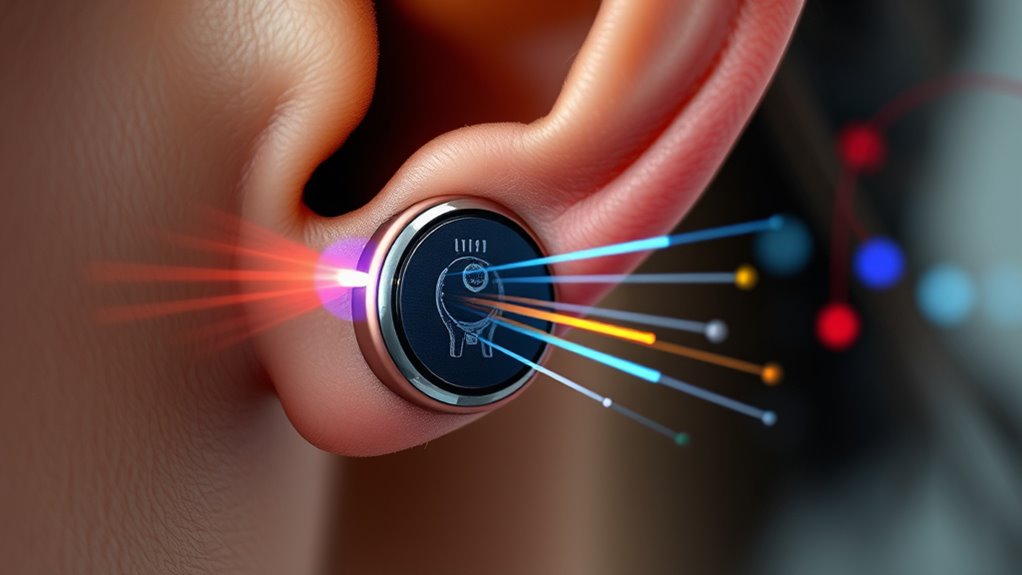
To convert sound waves into digital signals, the process begins with capturing the acoustic energy through a microphone. You need to understand sound wave physics, which explains how air vibrations translate into electrical signals. The microphone detects these vibrations and converts them into analog electrical signals that mirror the original sound wave. Next, these signals undergo digital signal encoding, where they are sampled at specific intervals and quantized into numerical values. This process transforms continuous sound wave information into a series of digital data points, making it suitable for processing by your cochlear implant. By accurately capturing and encoding the sound waves, the device guarantees that the subsequent stages can faithfully reproduce the auditory experience for the user. Additionally, understanding sound wave physics can help in optimizing the device’s performance and ensuring clearer sound transmission.
Transmission of Electrical Signals to the Electrode Array

After the digital signals are encoded, they are transmitted to the cochlear implant’s internal receiver-stimulator. This component receives the signals wirelessly or via a magnet, then converts them into electrical impulses. These impulses travel through intricate pathways to reach the electrode array implanted inside your cochlea. Proper electrode placement ensures the signals reach the correct nerve fibers, enhancing sound perception. To maintain signal fidelity, the device minimizes interference and signal loss during transmission. Key points include:
- Precise electrode placement within the cochlea
- High-quality wiring for accurate signal transfer
- Shielding to prevent signal interference
- Calibration for superior signal fidelity
- Signal transmission is optimized through advanced technology to ensure reliable delivery of electrical impulses.
This process guarantees that your brain receives clear, accurate electrical signals, setting the stage for effective auditory nerve stimulation.
Stimulation of the Auditory Nerve

The cochlear implant’s electrode array delivers precise electrical impulses directly to your auditory nerve fibers, triggering nerve signals that your brain interprets as sound. This process, called neural stimulation, bypasses damaged hair cells in your cochlea, allowing your nervous system to receive sound information. When electrical impulses reach the auditory nerve, they activate nerve fibers that send signals to your brain’s auditory centers. The timing and intensity of these electrical stimuli are carefully controlled to mimic natural sound signals, providing you with a sense of hearing. This targeted stimulation guarantees that your auditory nerve responds accurately, translating electrical impulses into meaningful auditory information. The effectiveness of this neural stimulation is essential for helping you perceive speech, music, and environmental sounds. Understanding neural stimulation is key to appreciating how cochlear implants restore hearing abilities.
Interpretation of Electrical Impulses by the Brain
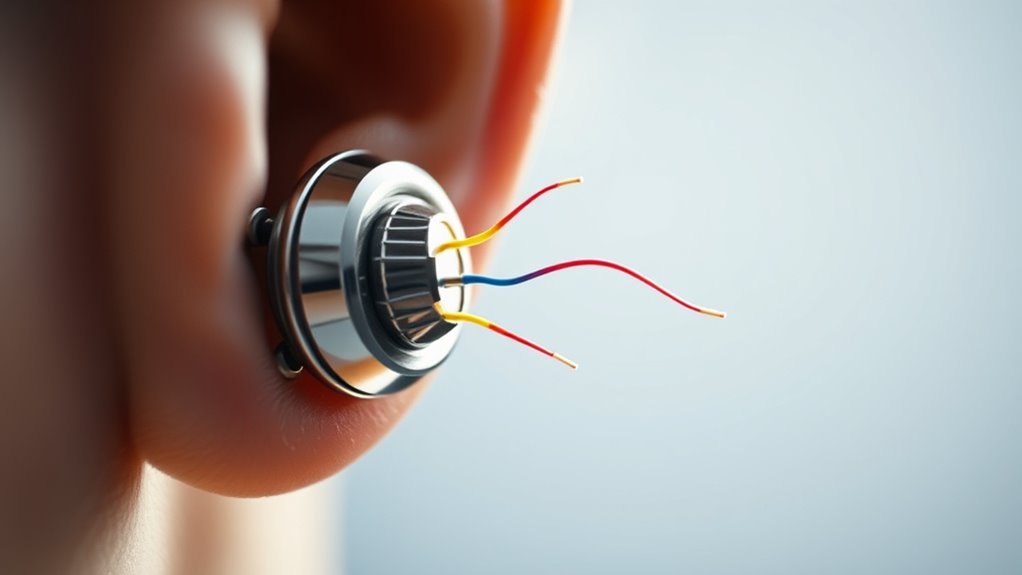
Once the electrical impulses reach your auditory nerve fibers, your brain takes over to interpret these signals as meaningful sounds. This process involves neural decoding, where your brain analyzes the patterns of impulses to identify different sounds, pitches, and volumes. Through perceptual interpretation, your brain assigns meaning, transforming raw electrical signals into familiar sounds like speech or music. You might notice:
- Recognizing speech patterns amid background noise
- Differentiating between high and low pitches
- Identifying various sound sources
- Making sense of complex auditory environments
Your brain’s ability to decode and interpret these impulses is vital for understanding sound. This seamless process helps you perceive and respond to your surroundings, even if the signals originate from a cochlear implant instead of natural hearing mechanisms. Neural decoding plays a crucial role in how effectively your brain interprets auditory information.
Advancements and Future Developments in Sound Conversion
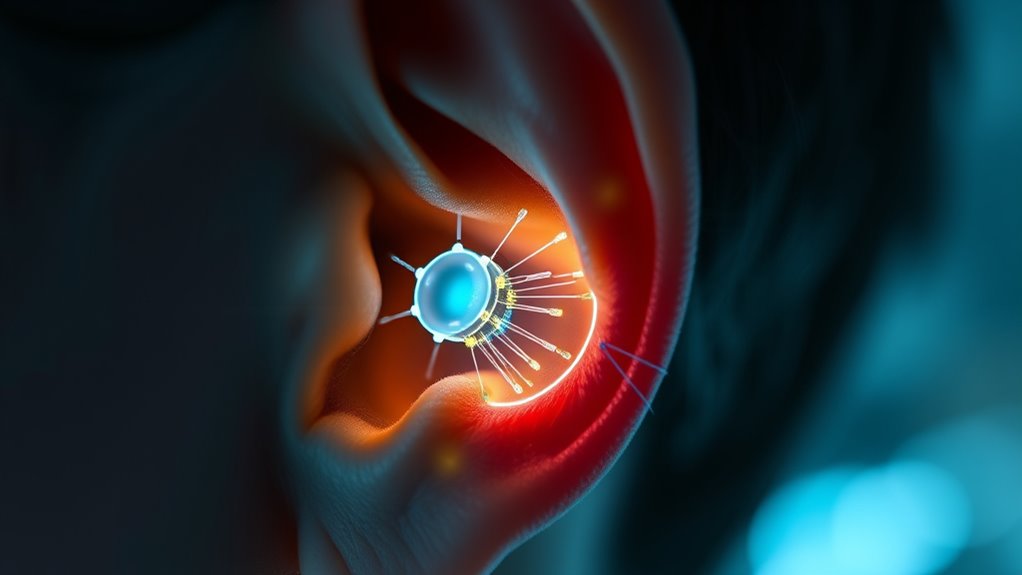
Recent advancements in sound conversion technology are rapidly enhancing cochlear implant performance, offering you more natural and accurate hearing experiences. Researchers are exploring neural regeneration techniques to repair damaged auditory nerves, which could improve how signals are transmitted to the brain. Additionally, developments in artificial auditory cortex technologies aim to bypass damaged neural pathways altogether, directly stimulating your brain’s hearing centers. These innovations could lead to clearer sound perception, better frequency resolution, and improved speech understanding, even in noisy environments. Future sound conversion methods may combine neural regeneration with brain-computer interfaces, making cochlear implants more seamless and intuitive. Exploring remote hackathons and other collaborative innovations can accelerate these technological breakthroughs. As these advancements progress, you’ll benefit from more sophisticated devices that restore hearing more authentically, transforming how you perceive sound in everyday life.
Frequently Asked Questions
How Does a Cochlear Implant Differ From a Hearing Aid?
A cochlear implant differs from a hearing aid because it bypasses damaged parts of your ear, directly stimulating your auditory nerve. While hearing aids amplify sound to enhance hearing, cochlear implants use advanced cochlear processing to convert sound into electrical impulses. These impulses are then sent to your brain, allowing you to perceive sound even if your ear’s hair cells are no longer functional.
Can Cochlear Implants Restore Normal Hearing?
Imagine opening a treasure chest of sound; cochlear implants don’t quite restore normal hearing but come close. They bypass damaged parts, sending electrical impulses directly to your auditory nerve. While they don’t promote neural regeneration or replicate all natural sounds, they greatly improve sound amplification, helping you understand speech and enjoy your environment better. It’s a remarkable step, but not a perfect mirror of your original hearing.
What Training Is Needed to Adapt to a Cochlear Implant?
To adapt to your cochlear implant, you’ll need auditory rehabilitation and speech therapy. These programs help your brain interpret the new sounds and improve your communication skills. You’ll attend regular sessions with a specialist who guides you through listening exercises and speech practice. Consistent effort and patience are key, as your brain learns to process electrical impulses into meaningful sounds, gradually enhancing your hearing and understanding.
Are Cochlear Implants Suitable for All Types of Hearing Loss?
Imagine your hearing as a puzzle, with different pieces representing various types of hearing loss. Cochlear implants can be a perfect fit if you’re an ideal candidate, typically with severe to profound sensorineural loss. However, they’re not suitable for all types, like conductive hearing loss or those with certain medical conditions. Your implant candidacy depends on your specific hearing puzzle, so consult an audiologist to see if an implant is right for you.
How Long Does It Take to Program a Cochlear Implant?
You might wonder how long it takes to program a cochlear implant. Typically, the device mapping process begins shortly after activation and involves multiple sessions. The programming timeline varies but usually spans several weeks, during which your audiologist fine-tunes the device to optimize sound quality. This process guarantees your cochlear implant delivers the best possible hearing experience, adapting to your unique needs through ongoing adjustments.
Conclusion
So, next time you marvel at crystal-clear sound from your device, remember it’s all thanks to tiny electrodes and complex signals. While cochlear implants turn sound into electrical impulses, you might find it ironic that they do all the work of your ears—yet still require you to interpret the world’s sounds. It’s a fascinating reminder that technology may help us hear, but understanding remains a uniquely human gift. Who knew silence could be so sophisticated?











